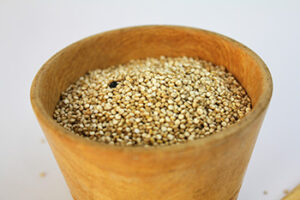Amaranth Description & Health Benefits
- Amaranth is part of the Amaranthaceae botanical family which also includes beet, chard, quinoa, spinach, sugar beet and Swiss chard. Amaranth is a pseudo cereal grain, meaning it is not a true cereal grain, but a seed. Pseudo cereals such as amaranth, quinoa and buckwheat are classified in the same category as grains due to their similar nutrient content and preparation techniques.
- Amaranth is naturally gluten-free and an outstanding powerhouse, nutrient rich food, making it a great choice for those on a gluten-free diet.
- Amaranth is an excellent source of fiber, iron, magnesium, phosphorus, manganese and a good source of calcium, zinc, copper, selenium, vitamin B6 and folate.
- Fiber supports a healthy digestive system by preventing constipation. Fiber rich foods also help you to feel fuller sooner which can help with weight control.
- Iron is required for growth and development and is needed to make red blood cells which carry oxygen throughout our bodies.
- Magnesium is needed to regulate muscle and nerve function, blood pressure and blood sugar levels.
- Phosphorus assists the body in creating energy and supports formation of bones and teeth.
- Manganese helps the body to form connective tissue, bones, sex hormones and blood clotting factors.
- Calcium helps to keep teeth and bones strong, and is used by nerves to carry messages between the brain and body.
- Zinc helps the immune system fight off viruses and bacteria and assists with wound healing and copper works with iron to form red blood cells and aids in the absorption of iron in the body.
- Selenium plays a significant role in thyroid health, creation of DNA and reproduction.
- Vitamin B6 assists with protein metabolism and is important in brain development during pregnancy and supports immune function.
- Folate is required to make DNA and other genetic material and protects against birth defects during pregnancy.
Purchasing, Selecting, Storing, and Preparing
- Amaranth grain is available for purchase year round in grocery stores. Select packages of grains that are tightly sealed. Amaranth may also be available in the bulk section of a grocery store. Ensure turnover is high to make sure grains are fresh. On prepackaged grains, check the sell by date to confirm freshness. Avoid grains that have a musty or oily scent as these are beyond their peak for freshness.
- Store the amaranth grain in an airtight container for up to six months in a dry, cool place such as your pantry or in the freezer for up to one year. Store amaranth flour in an airtight container for 1 to 3 months in a dry, cool place or in the freezer for 2 to 6 months.
- Prepare amaranth by adding amaranth to water, bring to a boil, reduce heat to simmer and cook until water is absorbed and desired consistency is reached. Use a 1:1 (1 part amaranth: 1 part water) for a firm texture, use a 1:2 for a softer texture and use a 1:3 to achieve a porridge consistency.
Nutrition Facts
1 cup cooked grain
Calories: 251 | Protein: 9.35 g | Fat: 3.89 g | Carbohydrate: 45.98 g | Fiber: 5.2 g | Calcium: 116 mg | Magnesium: 160 mg | Potassium: 332 mg | Folate: 54.1 mcg
ndb.nal.usda.gov
Recipes
Request an Appointment

